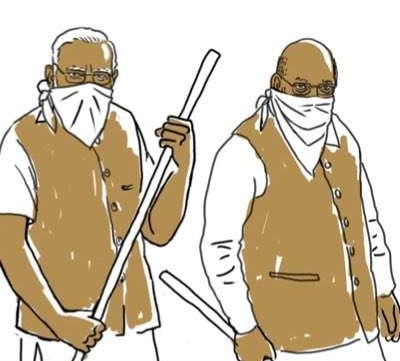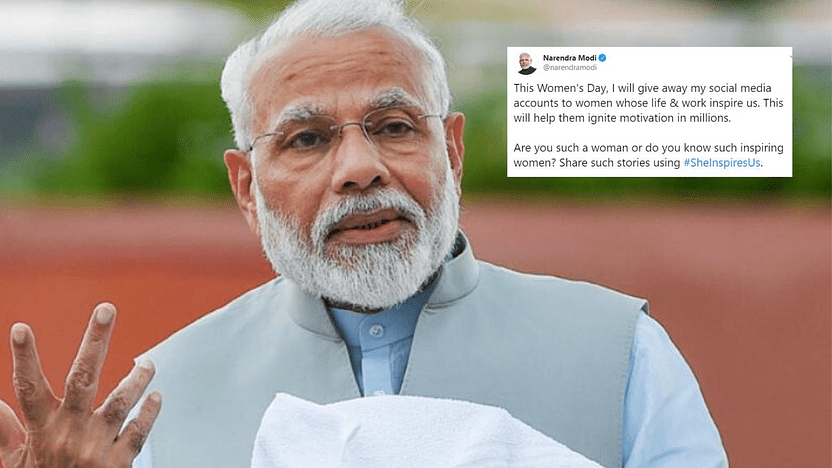On the 2nd of March, Prime Minister Modi announced his intent to give up his social media accounts. A day later, he revealed he wasn’t giving up, but handing it over to ‘inspirational women’ on women’s day who would get a chance to “share their thoughts with the world” via his accounts on Twitter, Instagram and Facebook. #SheInspiresUs began trending soon after, and Godi Media was quick to hail it as a ‘gift’, with TV news channels even covering it under breaking news. Social media, too, was quick to suggest who would fit the bill, with Journalist Rana Ayyub and the women of Shaheen Bagh being thrown in the mix.
Modi is the third most followed politician in the world, trailing only behind Barack Obama and Donald Trump. It is of no surprise then that Modi has an influential social media presence, and such a move was, in fact, seen as a ‘positive step’ towards amplifying the voices of women by his ardent supporters. But how has Modi really fared as the Prime Minister, and as the leader of the BJP, in giving voices to women?
The Skewed Politics Of Silence And Criticism
On the same day as Modi’s revelation, news about the horrors of sexual violence against Muslim women in the Delhi pogrom were reported. The state inflicted riots, which started on the night of 23rd February 2020 in Northeast Delhi, a Muslim majority area, has so far left 49 dead and over 200 injured. Women and children of Shiv Vihar were forced to flee for their lives, being robbed of their valuables. Muslim women told news media organisations about how a group of right wingers pulled down women’s pants at the Chandagh protest site, shouting “Yeh lo azaadi” while pointing at the women’s genitals. Police, instead of stopping the violence, have been reported to support the rioters, even attacking the peaceful protesters.
On the same day as Modi’s revelation, news about the horrors of sexual violence against Muslim women in the Delhi pogrom were reported. The state inflicted riots, which started on the night of 23rd February 2020 in Northeast Delhi, a Muslim majority area, has so far left 49 dead and over 200 injured.
The BJP government, meanwhile, have been nothing but inactive, working merely as silent viewers. The police, who work under the Ministry of Home Affairs, have been repeatedly accused of violence against peaceful protesters, especially against Muslim protesters. Kapil Mishra, a member of the BJP, whose inflammatory speech against Muslim protesters is said to have incited violence in the area, has now been given extra personal security on his claim that there is a threat to his life. Meanwhile, anti-CAA protestors have been detained, arrested, attacked and killed all over the country.
While violence in Delhi raged on, PM Modi entertained Donald Trump, known for his blatant sexist and racist remarks. On twitter, all that PM Modi did to acknowledge the riots was to appeal his “sisters and brothers of Delhi to maintain peace and brotherhood at all times.” Not only that, Modi has been active in his criticism against anti-CAA protestors, especially of the sustained protests by the Muslim women of Shaheen Bagh and the students of Jamia Millia Islamia. While campaigning before the Delhi elections, he called the protest a political conspiracy of Congress and Aam Aadmi Party, even accusing the protesters in Shaheen Bagh of disrupting peace in the name of upholding the Constitution. The women, on the other hand, had invited PM Modi for a conversation about their concerns to Shaheen Bagh on Valentine’s Day.
Also read: Donald Trump In India: BJP Entertaining A Serial Sexual Harasser Is Not New
It is clear that Modi has little interest in hearing the voices of those who criticise him. His practiced silence against violence targeted at Muslims and other minorities, his condemnation of those who object to his legislation, and his inaction against the provocative and inflammatory statements of his own party members make it clear that Modi has no desire of being inclusive. What then does his ‘celebration’ of International Women’s Day on social media really serve? And who are the women he is going to ‘allow’ to express their opinions on his profiles?
“Despite Being A Woman”
In 2015, Narendra Modi, on a visit to Bangladesh, praised Prime Minister Sheikh Hasina’s resolve to fight terrorism, “despite being a woman”. While his comment made international headlines, sexism against women in politics is nothing new. For years, women have been subjected to negative scrutiny – Priyanka Gandhi has often been called out for wearing jeans, comments have been made about Mayawati’s looks because she belongs to a particular caste, and Smriti Irani’s career as an actress has been subjected to vulgar commentary.
BJP with its staunch Hindutva ideological wing, the RSS, has made matters worse. They place a strong emphasis on women’s role in the domestic sphere of life, propagating how women are supposed to be house makers while men are supposed to earn. In fact, UP’s current chief minister, Yogi Adityanath, asserts that women who acquire male traits are ‘rakshasas’. Not to mention Hindutva’s attempts of upholding caste, which have resulted in an increase in caste based discrimination. As per a report by Amnesty International, attacks directed against Dalits were the highest between May 2015 and June 2019.
BJP with its staunch Hindutva ideological wing, the RSS, has made matters worse. They place a strong emphasis on women’s role in the domestic sphere of life, propagating how women are supposed to be house makers while men are supposed to earn. Not to mention Hindutva’s attempts of upholding caste, which have resulted in an increase in caste based discrimination.
Added to this is Modi’s own duplicity about women. The Beti Bachao, Beti Badhao policy launched in 2015 as an attempt to address the declining child sex ratio in India was considered to be an important step towards changing the outlook about girls. However, as per government’s date, about 56% of the funds allocated between 2015 and 2019 were used for media publicity, and 19.16% remained as unreleased funds. That leaves less that 25% of funds that were actually given to the states for the implementation of the policy.
While Modi hailed the abolition of Triple Talaq as a step towards progress, he upheld that the entry of women in the Sabarimala temple should not be allowed since it is a matter of tradition. And while the payment of dowry is a crime in India, Modi has appealed to farmers to give drip irrigation sets as dowry, or to plant five trees upon a daughter’s birth so that the trees could give funds for her marriage. Where is the difference in Modi’s perception about women as compared to the orthodox patriarchal and brahminical understanding of women and their roles?

It is also telling that there are only three women in Modi’s Cabinet since his re-election in 2019. In fact, 22 out of the 57 ministers in his cabinet have criminal cases against them, ranging from burglary, robbery, rape and murder to communal disharmony and terrorism. Added to this, are the Sanghis’ reactions to those who stand up to BJP’s problematic leaders. Two women were evicted out of their home when they protested against a rally led by Amit Shah; Kashmir has been under lockdown since august and there have been repeated efforts to show ‘peace’ in the region; Muslims find it difficult to rent houses in India.
It is also telling that there are only three women in Modi’s Cabinet since his re-election in 2019. In fact, 22 out of the 57 ministers in his cabinet have criminal cases against them, ranging from burglary, robbery, rape and murder to communal disharmony and terrorism.
If India’s cabinet of ministers themselves pose a threat to the people, how can a gimmicky move like handing over his social media accounts to women for a day change a whole system of oppression against minorities?
Where Is Empowerment?
In 2018-2019, Modi’s government tried to hide unemployment data. It was later revealed that unemployment was at 6.1%, highest in over four decades. Data trends have also revealed that women’s proportion in working force has been declining rapidly as per the Periodic Labour Force Survey published by NSSO. In 2017-18, the percentage of employed women fell to a new low of 23.3%, with Bihar having the lowest percentage of women working.
While some decline could be a reflection of an increase of women’s enrollment in higher education, a majority of women in the prime working age group (30-50) have reported that they were involved in domestic duties. The data also shows that there are only some specific areas of jobs women are employed in (agriculture related jobs in the rural sector, and a mix of jobs like domestic help, teaching, textile production etc in the urban sector). It was also apparent that women’s religion or caste affected their chances of getting a job with Muslim women’s having the lowest LFPR (Labour Force Participation Rate). The fact that upper caste women reported the lowest LFPR could be an indication of how social norms (women should be homemakers) have been affecting employment data.
Lack of financial and social security are plaguing the citizens of India. In the light of these realities, will Mr Modi ever hand over his accounts to those who criticise him? And what does it mean for a man so intrinsically patriarchal to let his social media be a mouthpiece for women?
As per Thomas Reuters Foundation’s Survey in 2018, India was deemed as the most dangerous country for women. India topped the charts in three key areas – discrimination because of cultural and religious traditions, risk of sexual harassment and violence against women, and trafficking of women. It was also amongst the worst five countries in discrimination based on socio-economic conditions, access to healthcare and non-sexual violence. Among 165 countries, India ranks 141 on the Global Peace Index 2019, slipping down by 5 places from 2018. In the World Press Freedom Index 2019, India ranks 140, going down by 2 places from 2018.
As far as ground realities are concerned, none of this data is surprising. Violence has increased; journalists, especially women journalists like Rana Ayyub and Faye D’Souza are hounded for speaking out against the government by Sanghis; and rights for women are advocated only in name. Lack of financial and social security are plaguing the citizens of India. In the light of these realities, will Mr. Modi ever hand over his accounts to those who criticise him? And what does it mean for a man so intrinsically patriarchal to let his social media be a mouthpiece for women?
Sir, if you really want to empower women, go to Shaheen Bagh and have a conversation. They wait for you in peace.
Also read: What The Modi Government Should Do For Indian Women?
Featured Image Source: The Quint
About the author(s)
Suyashi Smridhi is an aspiring writer and journalist from Patna. Her work has appeared on platforms like sbcltr.in, Coldnoon- International Journal of Travel Writing and Travelling Cultures amongst others. She is an alumnus of the Summer Institute, University of Iowa, a two-week creative writing cum cultural exchange program between India, Pakistan and the US.




